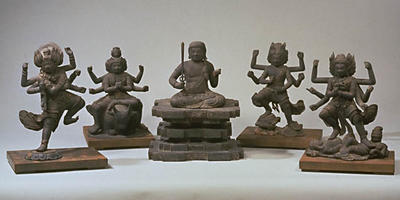:::::::::::::::::::::::::::::::::::::::::::::::::::::::::::::::::::::::::::::::::::::::::::::::::::::::::::::::::::::::::::
Godai Myo-O 五大明王 Five Great Myo-O
Godai-son 五大尊 Five Great Wisdom Kings
godai ... 地水火風空の五大
The Five Great Elements of the Universe
Godai Nyorai 五大如来 The Five Great Buddhas of Wisdom
Godairiki Bosatsu 五大力菩薩 Five Bosatsu of Great Power
- Fünf Bosatsu Gewaltiger Kraft
Gohoo bosatsu 五方菩薩 Five Bosatsu of the Five Directions
Go Himitsu Bosatsu 五秘密菩薩曼荼羅 Five Secret Bosatsu
. Godai 五大 Five Gread Buddhas .
- Introduction -
:::::::::::::::::::::::::::::::::::::::::::::::::::::::::::::::::::::::::::::::::::::::::::::::::::::::::::::::::::::::::::

source : kyobibutsuzou.com
:::::::::::::::::::::::::::::::::::::::::::::::::::::::::::::::::::::::::::::::::::::::::::::::::::::::::::::::::::::::::::
The Five Great Wisdom Kings
Godai Myo-O 五大明王

Copyright 1998, Nara National Museum. Nara, Japan.
This grouping is common in esoteric Buddhism. Ceremonies in front of these statues were used to pray for the destruction of a personal enemy or for political intrugues, for example during the war of the Genji and the Heike, where five priests at the temple Ninna-Ji in prayed to these five statues (godan no hoo 五壇の法) to win the war.

- quote
Godaison (Godai Myoo)
are five great Myoo placed in five directions, which is discussed in a set of two scrolls of "Ninnou Gokoku Hannya Haramitta Kyou" translated by a Chinese Buddhist priest Amoghavajra (Fukuu) and a scroll of "Shomuge Kyou" and consists of
Fudo (center), Kozanze (Gozanze) (east), Gundari (south), Daiitoku (west) and Kongoyasha (north ).
The images of Godaison are drawn as five separate paintings have been seen from the early Heian period and some examples such as Godaison-zo held at To-ji Temple in Kyoto are known. However, just like this painting, the style of Godai Myoo represented in one painting (Fudo Myoo at the center and others in each of the four directions) was established later than that and the images in Hakubyou (ink line painting) first appeared in the period between the late Heian period and the early Kamakura period.
In terms of the style, Fudo has a similar but more ample body than the Ao Fudo held in Shorenin in Kyoto and the faces are similar. It indicates an iconography of Genchoyou (Gencho's style). The halo with flames on the back is divided into seven parts as if they were the flames of a Karura (a fire-breathing creature from Japanese Hindu-Buddhist mythology). Two images of Doji have a style mixed with those held in Horaku-ji Temple in Osaka and Ruri-ji Temple (also known as Ruridera) in Hyogo. (Seitaka Doji is the same as Ni-Doji with a style of Hakubyo Genchoyou held at Godai-ji Temple.) The iconographical features of other four Myoo are very similar to the four Myoo excluding Fudo among Godaison in Godai-ji Temple and is also the same as the iconography of Enjinyou contained in "Besson Zakki." In a word, this painting was drawn in a newly established style by combining multiple styles of iconographies.
Unlike Ao Fudo, no colorful or fine patterns are applied to Fudo Myoo. The expressions such as the heavy colors, strongly applied Kumadori (shading) and expressive ink lines are rather different from the Buddhist paintings in the Heian period and indicate unique the features of the powerfully expressed Buddhist paintings in the Kamakura period.
- - - - - Look at the painting here :
- source : www.emuseum.jp/detail
:::::::::::::::::::::::::::::::::::::::::::::::::::::::::::::::::::::::::::::::::::::::::::::::::::::::::::::::::::::::::::

Jikkanshō Emakimono
- source : emakimono.it
:::::::::::::::::::::::::::::::::::::::::::::::::::::::::::::::::::::::::::::::::::::::::::::::::::::::::::::::::::::::::::

source : www.oparaq.com/shop

source : www.reihokan.or.jp
from Koyasan 高野山

source : www.garitto.com
:::::::::::::::::::::::::::::::::::::::::::::::::::::::::::::::::::::::::::::::::::::::::::::::::::::::::::::::::::::::::::

source : mall.fc2.com
stickers with the sanscrit letters -
bonji 梵字 ステッカー
.......................................................................

source : www.necomachi.com
五大猫明王 Five Meneki Neko Myo-O
.......................................................................

CLICK for more statues and paintings !
:::::::::::::::::::::::::::::::::::::::::::::::::::::::::::::::::::::::::::::::::::::::::::::::::::::::::::::::::::::::::::

. Ookuboji 大窪寺 Okubo-Ji, Shikoku 88 .
. 弘法寺 Kobo-Ji - Kagoshima Pilgrims 48 .
.......................................................................
The Great Five in Stone, Hashikura Yama
on the Pilgrimage to 36 Fudo Temples in Shikoku.

http://www.hashikura.or.jp/5myouou.htm
:::::::::::::::::::::::::::::::::::::::::::::::::::::::::::::::::::::::::::::::::::::::::::::::::::::::::::::::::::::::::::
Godai-son 五大尊 The Five Great Wisdom Kings
They are incarnations of the five Widsom Buddhas. Picture scrolls with these five deities, either five scrolls or one depicting them all, are called
"The Venerable Five" (godai son 五大尊).
Middle : Fudo Myo-O 不動明王
East : Goosanze 降三世明王
South : Gundari 軍茶利明王
West : Dai-iitoku 大威徳明王
North : Kongoo Yasha 金剛夜叉明王
In the Tendai sect, Uzusama Myo-O 鳥枢渋摩明王 is mostly depictede in the North. This version comes from China of the T'ang period, not from India. Other scriptures state that the five great wisdom kings where established in Japan.
- source - 五大明王
:::::::::::::::::::::::::::::::::::::::::::::::::::::::::::::::::::::::::::::::::::::::::::::::::::::::::::::::::::::::::::
The Ritual Bell with the five great wisdom kings (godai myo-o rei 五大明王鈴) is only to be found in Japan.

常福寺本尊五大明王 Temple Joofuku-Ji
reference - jofukuji/

- source : www.narahaku.go.jp
白銅五大明王宝塔鈴 Nara National Museum
:::::::::::::::::::::::::::::::::::::::::::::::::::::::::::::::::::::::::::::::::::::::::::::::::::::
You can even buy wirst bands with the Sanskrit letters of the five great Myo-O.
Here is the sample of Dai Iitoku 大威徳明王

:::::::::::::::::::::::::::::::::::::::::::::::::::::::::::::::::::::::::::::::::::::::::::::::::::::::::::::::::::::::::::

Godaidoo 五大堂 Godai-Do "Hall for the Great Five"
. . . . . Daikaku-In Kyoto 大覚寺五大堂
. goma Do 護摩堂, Gokoku-In, Kashima .
Godaidoo Myoo-Oo In 五大堂 明王院 Kamakura
. Godai-Do Matsushima 五大堂 松島 .
Seiryuzan Zuigan-ji 青龍山 瑞巌寺
. Fudo Temples - Introduction .
:::::::::::::::::::::::::::::::::::::::::::::::::::::::::::::::::::::::::::::::::::::::::::::::::::::::::::::::::::::::::::

. - Join Fudo Myo-O on facebook - Fudō Myō-ō .
:::::::::::::::::::::::::::::::::::::::::::::::::::::::::::::::::::::::::::::::::::::::::::::::::::::::::::::::::::::::::::
. Pilgrimages to Fudo Temples 不動明王巡礼
Fudo Myo-O Junrei - Fudo Pilgrims .
[ . BACK to WORLDKIGO . TOP . ]
[ . BACK to DARUMA MUSEUM TOP . ]
:::::::::::::::::::::::::::::::::::::::::::::::::::::::::::::::::::::::::::::::::::::::::::::::::::::::::::::::::::::::::::
Iwatsuki Fudo 岩槻不動
ReplyDeleteNr. 31 光岩山 - 釈迦院 Shaka-In - 彌勒密寺 Mirokumitsu-Ji
岩槻大師 Iwatsuki Daishi
with
Godai Myo-O statues
.
https://fudosama.blogspot.com/2019/02/iwatsuki-fudo-saitama.html
.